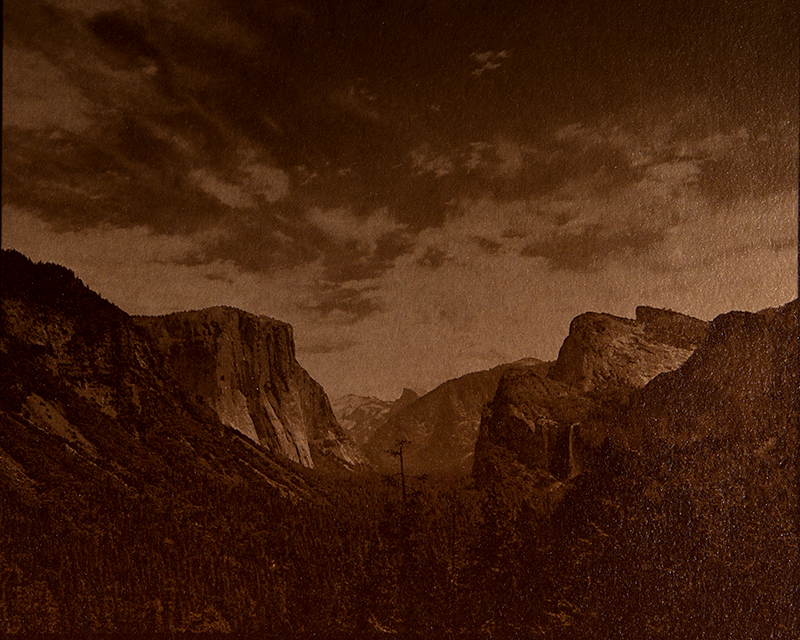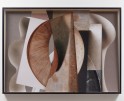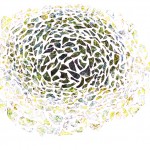Marcus DeSieno: Cosmos and American West

© Marcus DeSieno, Cosmos, “A Photograph of Saturn Eaten by Bacteria Found on an Adulterer’s Engagement Ring”
The Roman philosopher, Cicero, is noted as saying, “Notatio naturae, et animadversio perperit artem – Art is born of the observation and investigation of nature.” You could insert the word “science” for art, and it would be just as true. The foundation of photography is rooted in the alchemy of art and science. The photography of Marcus DeSieno speaks to that transformative power of science and art. I recently asked Marcus to share a little about his process.
“My working process as an artist is rather simple. Very small questions will pop up in my mind, I’ll try to answer them in an empirical way, and sometimes an art object morphs out of this process. In the case of the Cosmos series, I thought to myself one day, ‘What kind of bacteria is growing on my iPhone?’ That simple question led me to growing bacteria in a petri dish from the phone. It’s from these simple experiments in my studio that I end up deriving my work. Starting with that sample, I became fascinated with bacteria—this invisible life that is teeming around the globe, taking up the majority of the biomass of this planet yet unseen by our human eyes. I wanted to harness these unseen organisms in the creation of something visible, so I began to experiment with how I could use the growth of bacteria in the creation of an aesthetic work. I paired the bacteria with these images from outer space on slide film, and the destructive capacity of the bacteria did the rest.”
Marcus is not a trained scientist, but his powers of observation have been honed since he was a kid. “My interest in science and nature has really been a lifelong obsession. When I was eight, my parents bought me a cheap microscope, and I became entranced by how that optical device transformed something I thought I understood into something so profound and complex. That experience has altered how I perceive the natural world and has resulted in a lifelong fixation with not only photographic technology and optical machines, but also the ways in which their evolution has fundamentally altered how we perceive the larger universe around us.”
For this feature I wanted to share Marcus’ Cosmos series “a futile existential performance to understand my worth in this cosmic sea” paired with his early series American West which is a gorgeous set of toned albumen prints from Google Streetview screenshots that are reminiscent of Carlton Watkins. You get a great sense of his artistic intentions from these series. Marcus explains, “I want to interrogate the function of obsolescent analog photography in an age of digital uniformity. The invention of photography has fundamentally altered our perceptions of the universe around us. I’m interested in this rich history and how photography has played a role in shaping our current relationship with nature. So, I often use antiquated photographic process and appropriated imagery in order to speak to this history.”
Marcus is from Albany, New York and recently finished his MFA from University of South Florida and he has a BA from Marlboro College in Vermont a Degree in Documentary Studies/Documentary Photography from the SALT Institute in Maine. A solo exhibition of his series Parasites opens in July 2015, at the Vermont Center for Photography. Parasites will also be featured in the Photoville’s The Fence Exhibition traveling to Brooklyn, Boston, and Atlanta in 2015. Marcus was a 2014 and 2013 Photolucida Critical Mass Finalist, juried into Review Santa Fe 2015 and his work has been featured in many publications such as Slate, PDN Magazine, Huffington Post, Wired, Smithsonian Magazine and National Geographic’s Proof.

© Marcus DeSieno, Cosmos, “A Photograph of Pandora’s Galaxy Cluster Eaten by Bacteria Found in My Cat’s Litter Box”
Cosmos
On the surface, Cosmos is a meditative exercise to understand how I fit into this vast spectrum and scale of the universe, a futile existential performance to understand my worth in this cosmic sea as I meld the microscopic and macrocosmic together into a singular plane. I try to exert control over the forces of nature. I find bacteria, breed them on photographic film, and then destroy them, forcing a mass extinction in the process of scanning and creating the art object. I play both creator and destroyer. It is a cruel and narcissistic means of asserting dominance over nature in an attempt to reflect on, or refute, my own powerlessness and insignificance in this vastness of existence.

© Marcus DeSieno, Cosmos, “A Photograph of the Planet Venus Eaten by Bacteria Found Inside My Ex-Girlfriend’s Vagina”
Cosmos is in many ways a desire to further explore the physical manifestations of what I can and cannot create through tangible anachronistic photographic media. I am subverting the original function of analog film and using nature to literally destroy photographic representation as the bacteria imprint their own index in the process. Cosmos is very much an interrogation of photographic representation through the destruction of photographic material.

© Marcus DeSieno, Cosmos, “A Photograph of the Reticulum Constellation Eaten by Bacteria Found on My Television’s Remote”

© Marcus DeSieno, Cosmos, “A Photograph of the Baby Boom Galaxy Eaten by Bacteria Found in My Father’s Saliva”

© Marcus DeSieno, Cosmos, “A Photograph of the Snake Nebula Eaten by Bacteria Found Inside the Confessional of My Childhood Church”

© Marcus DeSieno, Cosmos, “A Photograph of a Gas Cloud Above a Black Hole Eaten by Bacteria Found Inside a Glory Hole”

© Marcus DeSieno, Cosmos, “A Photograph of an Elliptical Galaxy Eaten by Bacteria Found on My Toilet Seat”

© Marcus DeSieno, Cosmos, “A Photograph of a Star Cluster Eaten by Bacteria Found on My iPhone’s Screen”

© Marcus DeSieno, Cosmos, “A Photograph of the Crab Nebula Eaten by Bacteria Found on a Table at a Red Lobster Restaurant”

© Marcus DeSieno, Cosmos, “A Photograph of the Whirlpool Galaxy Eaten by Bacteria Found in a Motel’s Heart-Shaped Hot Tub”
American West
Toned Albumen Prints from Google Streetview Screengrabs
Posts on Lenscratch may not be reproduced without the permission of the Lenscratch staff and the photographer.
Recommended
-
Photography Educator: Erin Ryan StellingJanuary 9th, 2026
-
The Female Gaze: Alysia Macaulay – Forms Uniquely Her OwnDecember 17th, 2025
-
Bill Armstrong: All A Blur: Photographs from the Infinity SeriesNovember 17th, 2025
-
Robert Rauschenberg at Gemini G.E.LOctober 18th, 2025
-
Erin Shirreff: Permanent DraftsAugust 24th, 2025





























































